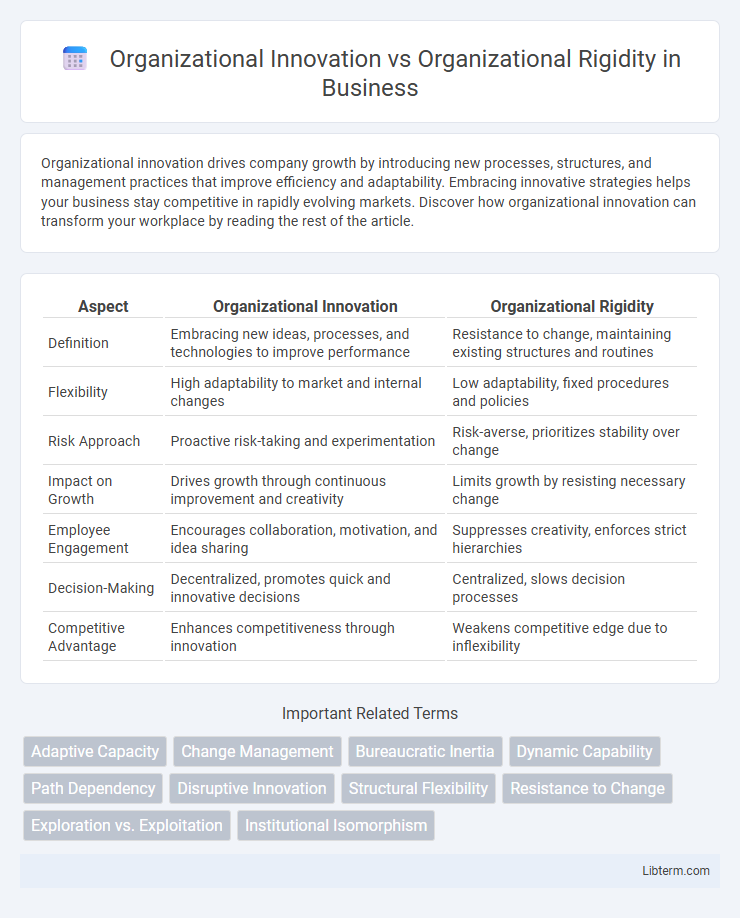Organizational innovation drives company growth by introducing new processes, structures, and management practices that improve efficiency and adaptability. Embracing innovative strategies helps your business stay competitive in rapidly evolving markets. Discover how organizational innovation can transform your workplace by reading the rest of the article.
Table of Comparison
| Aspect | Organizational Innovation | Organizational Rigidity |
|---|---|---|
| Definition | Embracing new ideas, processes, and technologies to improve performance | Resistance to change, maintaining existing structures and routines |
| Flexibility | High adaptability to market and internal changes | Low adaptability, fixed procedures and policies |
| Risk Approach | Proactive risk-taking and experimentation | Risk-averse, prioritizes stability over change |
| Impact on Growth | Drives growth through continuous improvement and creativity | Limits growth by resisting necessary change |
| Employee Engagement | Encourages collaboration, motivation, and idea sharing | Suppresses creativity, enforces strict hierarchies |
| Decision-Making | Decentralized, promotes quick and innovative decisions | Centralized, slows decision processes |
| Competitive Advantage | Enhances competitiveness through innovation | Weakens competitive edge due to inflexibility |
Understanding Organizational Innovation
Organizational innovation drives competitive advantage by fostering adaptability, creativity, and continuous improvement within the company's processes, products, and services. It involves integrating new technologies, encouraging collaborative culture, and leveraging data-driven decision-making to respond swiftly to market dynamics. Embracing innovation enables organizations to overcome rigidity, break traditional boundaries, and sustain long-term growth.
Defining Organizational Rigidity
Organizational rigidity refers to a company's resistance to change due to entrenched processes, hierarchical structures, and fixed mindsets that limit adaptability and responsiveness to market shifts. This rigidity often results in reduced innovation capacity, slower decision-making, and decreased competitive advantage in dynamic business environments. Understanding organizational rigidity is crucial for developing strategies that foster flexibility and promote continuous innovation.
Key Drivers of Innovation in Organizations
Key drivers of organizational innovation include a culture that encourages risk-taking, leadership support for new ideas, and investment in research and development. Access to diverse talent and collaborative networks fosters creative problem-solving and accelerates the implementation of innovative solutions. In contrast, organizational rigidity often stems from hierarchical structures, resistance to change, and entrenched processes that stifle creativity and slow adaptation to market dynamics.
Causes and Symptoms of Rigidity
Organizational rigidity often stems from hierarchical structures, resistance to change, and entrenched routines that limit flexibility and adaptation. Common symptoms include slow decision-making processes, reduced employee creativity, and an inability to respond effectively to market shifts or technological advancements. This rigidity inhibits innovation, leading to stagnation and decreased competitive advantage in dynamic business environments.
Impact on Business Performance
Organizational innovation drives business performance by fostering adaptability, enhancing competitive advantage, and promoting continuous improvement through creative problem-solving and technology adoption. In contrast, organizational rigidity often hampers responsiveness to market changes, leading to stagnation, reduced efficiency, and diminished profitability. Companies embracing flexibility and innovation outperform rigid organizations by effectively navigating uncertainty and accelerating growth.
Leadership’s Role in Fostering Innovation
Leadership plays a pivotal role in driving organizational innovation by cultivating a culture that encourages experimentation, risk-taking, and continuous learning. Effective leaders dismantle organizational rigidity by promoting open communication, empowering employees, and aligning innovation initiatives with strategic goals. By modeling adaptive behaviors and supporting resource allocation for creative projects, leaders ensure sustained innovation and competitive advantage.
Consequences of Persistent Rigidity
Persistent organizational rigidity stifles innovation by limiting adaptive capacity and responsiveness to market changes, often resulting in decreased competitiveness and slower growth. Firms entrenched in rigid structures face higher risks of obsolescence due to failure in adopting new technologies or processes. This inflexibility can lead to employee dissatisfaction and turnover, further hindering innovation and organizational performance.
Strategies for Overcoming Organizational Rigidity
Strategies for overcoming organizational rigidity include fostering a culture of continuous learning and adaptive leadership to encourage flexibility and innovation. Implementing cross-functional teams and agile project management enhances collaboration and rapid response to market changes. Leveraging digital transformation tools enables organizations to break traditional silos, streamline processes, and support scalable innovation initiatives.
Balancing Stability and Adaptability
Organizational innovation drives adaptability by fostering creativity and embracing change, which is essential for competing in dynamic markets. In contrast, organizational rigidity emphasizes stability and established processes, ensuring operational efficiency and risk minimization. Achieving a balance between these forces enables organizations to remain resilient, sustaining continuous improvement without compromising core values and structures.
Future Trends in Organizational Innovation
Future trends in organizational innovation emphasize agile structures, digital transformation, and AI integration to foster adaptability and continuous improvement. Companies adopting decentralized decision-making and collaborative platforms enhance creativity and responsiveness, counteracting organizational rigidity. Embracing these innovations drives competitive advantage and sustainability in rapidly changing markets.
Organizational Innovation Infographic

 libterm.com
libterm.com